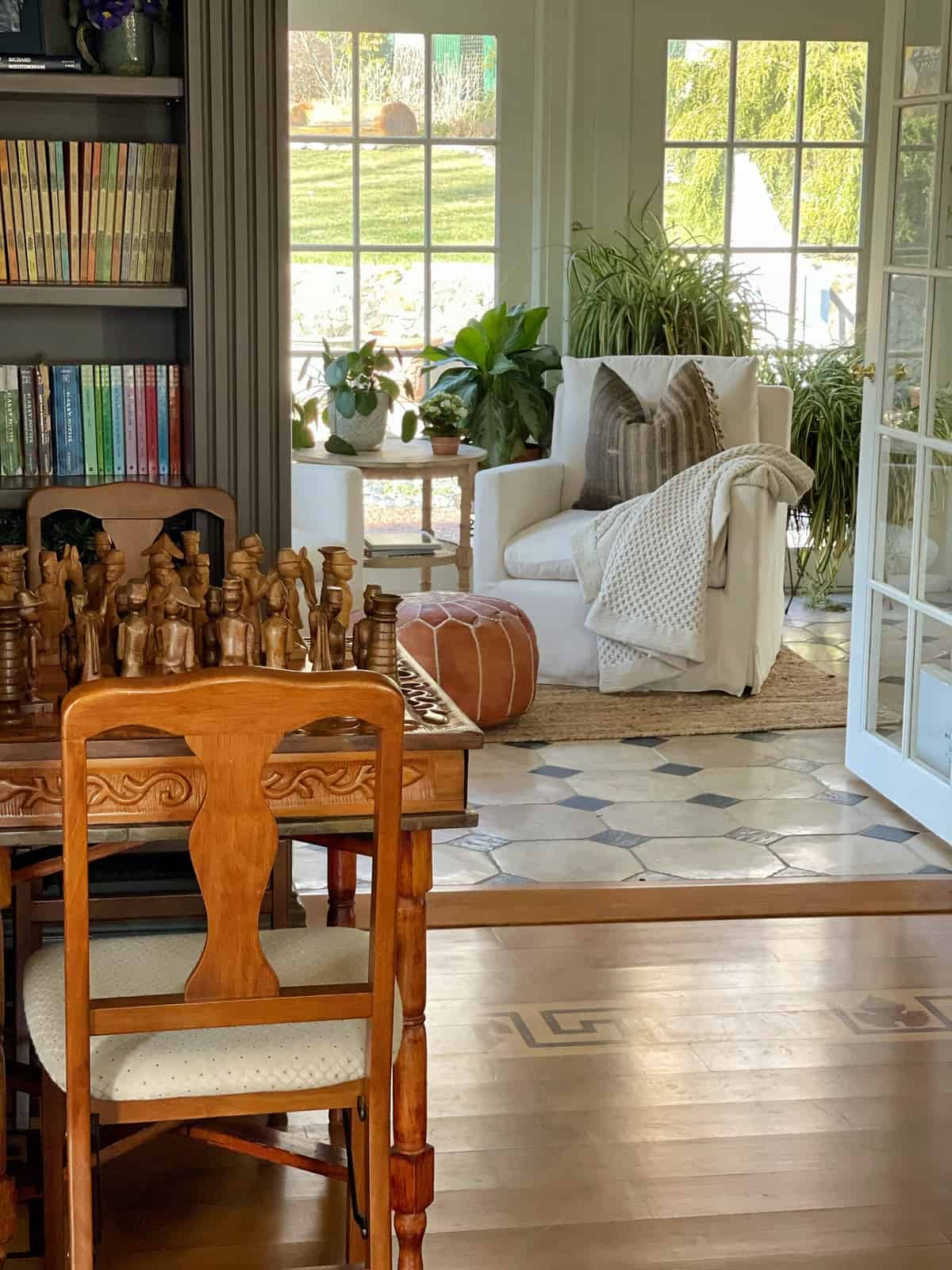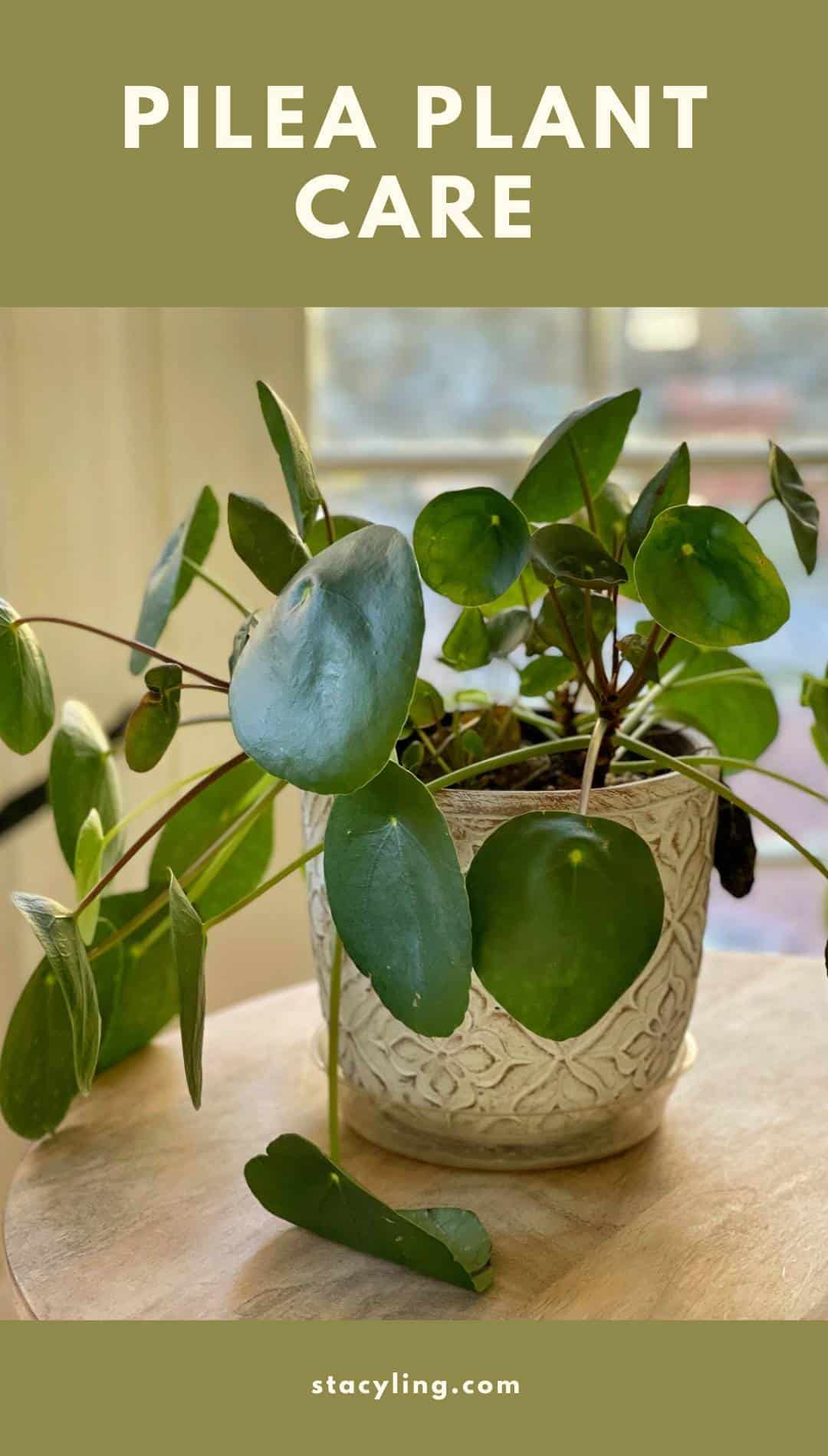Pilea peperomioides (Chinese Money Plant) care made easy! Tips for thriving plants, propagation, and troubleshooting.
Like many of you, I was first introduced to the Chinese Money Plant by the original influencer herself, Martha Stewart. (She really knows her houseplants!) After watching her rave about these adorable plants, I just had to get one.
And let me tell you, I absolutely LOVE this little gem. What started as a single, inexpensive plant has multiplied into four thriving Pilea peperomioides, and the mother plant just keeps on giving!
Every year, I separate the baby plants and repot them in terracotta pots – it’s so easy! While some brighten up my home and purify the air, I’ve also gifted many to friends and family. These plants practically propagate themselves, making them the perfect present.
Want to learn the secrets to growing your own thriving Pilea plants? Keep reading to discover everything you need to know about these fun and easy-care indoor wonders!
(Posts on stacyling.com may contain affiliate links. Click HERE for full disclosure.)

About Pilea Peperomioides (Chinese Money Plant)
Pilea plants, belonging to the Urticaceae family, are beloved for their unique foliage and easy care. You might know them as Chinese Money Plants, Friendship Plants, or even Pancake Plants – nicknames inspired by their charming coin-shaped leaves. The most popular variety, Pilea peperomioides, is said to bring good luck to its owner.
Native to Central and South America, Pilea peperomioides has become a global houseplant sensation. Its distinctive, flat leaves and simple care requirements make it a perfect choice for both beginner and experienced plant enthusiasts.
Types of Pilea Plants
There are several different pilea plant varieties that include:
- Pilea Peperomioides Plant
- Pilea Cadierei
- Pilea Involucrata
- Pilea Mollis
- Pilea Microphylla
- Pilea Nummulariifolia
- Pilea Depressa
Do you grow any of them? If so, let me know in the comments because I’d love to hear about your favorites!

Why Grow Pilea Plant?
If you are not convinced yet as to why you should grow a pilea plant, here are 5 reasons you should run, not walk, to the nursery to buy your first one.
- Great indoor plant for beginners. Pilea plants are relatively low maintenance and easy to care for, making them a great choice for beginners or those with busy schedules.
- They have a unique appearance. The round, coin-shaped leaves of the friendship plants make them a visually interesting addition to any indoor space.
- Air-purifying. Coin plants are known to help purify the air by removing pollutants and producing oxygen.
- Easy to propagate. Pilea plants can be easily propagated from stem cuttings or division, allowing you to create new plants for yourself or to share with friends.
- Versatile. They can be grown in a variety of settings including in pots, hanging baskets, or as part of a dish garden. But they can also be used as ground cover in terrariums.

Chinese Money Plant Care
The pilea plant is a great houseplant that is relatively easy to grow with very little maintenance. I highly recommend growing them if you are just starting out with indoor plant care. Here is what you need to know to grow happy and healthy pilea plants.
Light Exposure
Pilea plants prefer bright indirect sunlight but can tolerate a little bit of sun. Intense direct sunlight can cause their leaves to burn. My pileas are kept in the sunroom on the north side of my house and seem to be pretty happy there.
When I cared for it at my former home, I kept them out of direct sunlight between two windows on the south side of my home. So they got a lot of light there, but it was not getting directly hit by the sun at all.
To style pilea plants in spaces with lower light conditions, consider adding a grow light. There are so many great options out there depending on placement, but I love these that you can stick right in the pot and set on a timer.
Best Soil Mix For Pilea Peperomioides
Use a well-draining potting mix in a pot with a drainage hole to prevent water from sitting in the soil for too long. You can use a standard commercial potting mix and amend it with perlite or pumice to increase drainage. Aim for a ratio of about 2:1 potting mix to perlite. Another option is to use a cactus and succulent mix, as these are formulated for plants that prefer well-draining soil.
Avoid using heavy soils, such as those with high clay content, as these can retain too much moisture and suffocate the roots.
NOTE: While these recommendations provide a good starting point, it’s important to remember that the ideal soil mix can vary depending on your specific environment and growing conditions. You may need to experiment a bit to find what works best for your Pilea Plant.
Shop for Pots

Temperature
Pilea plants are comfortable in average room temperatures (65-75°F) but can handle brief temperature fluctuations.
I move my pilea plants outdoors when all danger of frost has passed. It stays outside all summer long until it comes back inside before the first frost in fall. While they are outside, I keep them in a location that is covered and out of direct sunlight. So a covered porch or along the house under a roofline is perfect for them.
Humidity
Pilea plants prefer high humidity, but can adapt to low humidity too if necessary. To increase humidity levels in your home, you can do one of the following:
- place a tray of water near the plant
- mist the leaves occasionally,
- add a humidifier
- or group several plants together to create an indoor microclimate.
Watering Pilea Peperomioides Plant
It is important to water pilea plants regularly, but allow the soil to dry out slightly between waterings. Over-watering can stress the plant and lead to root rot. So be really careful not to overwater.
But how do you know when the right time to water is? It’s not on the same day every week. If you do that to a pilea, you’ll overwater it for sure.
Instead of watering on the same day every week, check your plants to see if they need to a drink. This can be achieved by using a moisture meter like this or something like a chopstick to see if it is dry down by the roots. (I wrote all about how to do this well in this post: cake batter test for plants).
For best results, when water allow excess water to drain out into a drainage dish or the sink and ensure the soil is fully saturated.
Fertilizing Your Pilea Plant: Less is More
Pilea peperomioides are not heavy feeders, meaning they don’t require a lot of fertilizer. Over-fertilization can actually harm them, leading to salt buildup and root burn. Use a balanced liquid fertilizer with a 3-1-2 ratio (Nitrogen-Phosphorus-Potassium) or a similar formulation.
Fertilize your Pilea during its active growing season, which is typically spring and summer. Reduce or stop fertilization during the fall and winter months when the plant’s growth slows down.
A general rule of thumb is to fertilize your Pilea once a month during the growing season. It’s crucial to dilute the fertilizer to half the recommended strength on the label to avoid over-fertilization.
Lately, I’ve been using an organic fertilizer like this one so I can feed my houseplants all year round.
Signs of Over-Fertilization
Watch out for these signs, which may indicate you’re over-fertilizing:
- Wilting: Even when the soil is moist.
- Leaf tip burn: Brown or scorched tips on the leaves.
- Salt buildup: A white crust on the soil surface.
If you notice any of these signs, reduce the frequency or strength of your fertilization.

Repotting Your Pilea: Giving It Room to Grow
Pilea peperomioides typically don’t need frequent repotting. However, you’ll eventually need to give them a new home as they grow. Here’s how to know when and how to repot your Pilea:
Signs Your Pilea Needs Repotting
- Roots circling the bottom: When you see roots growing out of the drainage holes or circling the bottom of the pot, it’s a sign your Pilea is root-bound.
- Slowed growth: If your Pilea’s growth seems stunted despite proper care, it might be time for a larger pot.
- Soil drying out quickly: If the soil dries out very quickly after watering, the roots may be filling the pot, leaving little room for soil.
Choosing the Right Pot and Soil
- Slightly larger pot: Choose a pot that’s only slightly larger than the current one, about 1-2 inches wider in diameter.
- Drainage is key: Ensure the new pot has drainage holes to prevent waterlogging.
- Well-draining soil: Use a well-draining potting mix, as mentioned earlier.
Repotting Pilea Plant Directions
- Prepare the new pot: Add a layer of drainage material (like pebbles) to the bottom of the new pot.
- Remove the Pilea: Gently tap the bottom of the old pot or squeeze the sides to loosen the root ball.
- Loosen the roots: Carefully loosen any circling roots around the edges of the root ball.
- Plant in the new pot: Place the Pilea in the new pot, ensuring the top of the root ball is level with the rim of the pot.
- Fill with soil: Fill the space around the root ball with fresh potting mix, gently firming it down.
- Water thoroughly: Water the plant thoroughly after repotting, allowing excess water to drain.
After Repotting Care
- Monitor watering: Be mindful of watering, as the plant may need less frequent watering in a larger pot.
- Avoid direct sunlight: Keep the newly repotted Pilea out of direct sunlight for a few days while it adjusts.

Common Pest and Disease Problems With Pilea Peperomioides
While Pilea peperomioides are generally hardy, they can occasionally fall victim to common houseplant pests or diseases. Here’s what to watch out for and how to address these issues:
Pests
- Mealybugs: These small, white, cottony insects suck sap from the plant. Dab them with rubbing alcohol or use insecticidal soap.
- Spider mites: Tiny pests that cause stippling on leaves and may produce fine webbing. Increase humidity, wipe leaves with a damp cloth, or use insecticidal soap.
- Fungus gnats: Small, flying insects that thrive in moist soil. Allow the soil to dry out more between waterings and use sticky traps.
Diseases
- Root rot: Caused by overwatering and poor drainage, leading to mushy, blackened roots. Repot the plant in fresh, well-draining soil and reduce watering frequency.
- Leaf spot diseases: Fungal or bacterial infections that cause spots on leaves. Remove affected leaves, improve air circulation, and avoid overhead watering.
Prevention is Key
- Inspect Regularly: Check your Pilea regularly for signs of pests or diseases.
- Proper Care: Provide the right light, water, and humidity to keep your plant healthy and less susceptible to problems.
- Quarantine New Plants: Isolate new plants for a few weeks to prevent the spread of pests or diseases.

How to Propagate Pilea by Stem Cutting
Propagating pilea is a simple process that can be done using stem cuttings. Here’s how to do it:
- Cut a stem with a few leaves from the parent plant using clean, sharp scissors or a knife.
- Remove the lower leaves from the stem cutting, leaving only a few at the top.
- You can dip the cut end of the stem into rooting hormone powder but it is not necessary.
- Place the stem cutting in a glass or jar filled with water, making sure that the cut end is submerged.
- Change the water every few days to prevent bacteria buildup.
- After 2-4 weeks, roots should begin to grow from the cut end of the stem.
- Once the roots are 1-2 inches long, the stem cutting can be planted in fresh potting soil.
- Keep the soil moist but not waterlogged, and place the newly planted pilea in bright indirect light.
It is also possible to propagate pilea directly in soil, but rooting in water first is easier with greater success.

Propagating Pilea Plant by Division
Making new pilea plants from division is super easy and makes a great gift idea if you want to give them away.
- Make sure you are dividing healthy Chinese money plants that are free from pests and disease.
- Remove the pilea plant from its container.
- Using your fingers, gently split off the pilea babies from the main plant.
- Repot the mother plant in fresh potting soil.
- Then pot up each baby plant in smaller pots with fresh potting soil too.
What If You Don’t Want to Divide Your Pilea Plants?
If you don’t want to divide your Chinese money plant into smaller plants but want to maintain optimal plant health, it’s a good idea to repot it in a bigger pot. This will keep the coin plant from getting rootbound in its existing container and will help keep the plant healthy.

Why Does My Money Plant Have Yellow Leaves?
If your money plants starts to develop yellow leaves, it’s possible you are overwatering your plants, which means the soil moisture is too high. If you only see a few at the bottom of the plant, they are likely older leaves dying off which is normal for the plant.
If however, you are seeing yellow leaves in other spots, we’ve got to drill down on the cause. Remove the plant from the pot and check the roots. Cut off all of the yellow foliage and gently take off the soil from the plants root system. If the roots are soggy or smell bad, cut them off with clean snips, clean them with 3% hydrogen peroxide and then repot it in fresh well-draining soil.
Final Thoughts About Growing Chinese Money Plant
As you can see, Pilea peperomioides truly earns its place as a houseplant favorite. From its quirky, coin-like leaves to its easy-going nature, there’s so much to appreciate about this little gem.
Personally, I LOVE how readily it produces baby plants, making it a joy to propagate and share with loved ones. There’s something special about gifting a piece of your own thriving plant to brighten someone else’s home.
Whether you’re a seasoned plant parent or just starting your indoor gardening journey, Pilea peperomioides is a fantastic choice. With a little attention to its basic needs – well-draining soil, the right amount of light, and mindful watering – you’ll be rewarded with a happy, healthy plant that brings a touch of whimsy and good fortune to your space.
Happy growing! 🌱
Are you growing the coin plant? Do you have a favorite pilea plant variety? I would love to know more in the comments below.
For more information about how to grow Pilea Plant, please read this article from the North Carolina State Cooperative Extension.
To drill down on houseplant care basics and growing an indoor garden that thrives, please read my articles:
- Easy Houseplants for Busy People: The Low-Maintenance Approach to Growing an Indoor Garden
- From Shop to Home: How to Acclimate Your Tropical Plants
- Stop Guessing and Master Watering Indoor Plants Like a Pro
- How to Revive Houseplants You Thought Were Goners
- Is Your Houseplant Getting Enough Light? Here’s How to Tell.
Thank you for visiting the blog today!
Enjoy your day! xo


Thank you so much for following along.
Enjoy a beautiful day! xo






